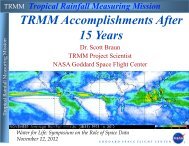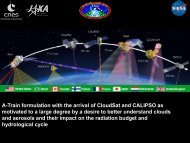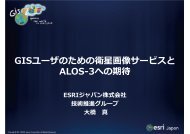ALOS Data Users Handbook
ALOS Data Users Handbook
ALOS Data Users Handbook
You also want an ePaper? Increase the reach of your titles
YUMPU automatically turns print PDFs into web optimized ePapers that Google loves.
Section 3 Outline of <strong>ALOS</strong> Satellite System3.3.4 Attitude and Orbit Control Subsystem (AOCS)<strong>ALOS</strong>'s Attitude and Orbit Control Subsystem (AOCS) has function to acquire information of satellite attitudeand location by using Earth Sensor (ESA), Inertia Reference Unit (IRU), Star Tracker (STT), and GPS Receiver(GPSR), and also has function to keep satellite correct attitude and orbit by driving Reaction Control Subsystem(RCS) gas jet, Reaction Wheel (RW) and Magnetic Torquer (MTQ).To make world map of 1/25,000 scale derived from PRISM's 2.5 meters resolution image, spacecraft's attitudemust be kept and determined precisely as we have never developed. The specifications of AOCS are as follows:• Pointing Stability (Maximum of satellite’s stagger)- Four ten-thousandths of degrees per 5 seconds or less (4.0e-4deg/5sec)• Pointing Determination Accuracy (error of satellite’s direction)- Four ten-thousandths of degrees (4.0e-4deg) at onboard processer- Two ten-thousandths of degrees (2.0e-4deg) at off-line processing on the ground• Location Determination Accuracy (error of orbit satellite): 1m<strong>ALOS</strong> Star Tracker (STT) can determine satellite attitude with high accuracy of 0.0002deg comparing observedlocation and magnification of stars with its own star catalog. The large three hoods are installed to shield stardetector from direct or reflected Sun light. STT mormally operates by using STT-1 facing forward and STT-3facing backward. However in the case of interference of the Moon etc, STT will change its operation mode usingSTT-2 located at center to avoid malfunction for attitude detecting. Surface of the hoods are covered with MultiLayer Insulation (MLI) to keep STT's function normally controlling its thermal condition in the severeenvironment of direct Sunlight and darkness of night.There are two frequencies (L1 and L2) of GPS signals we can receive from GPS satellites. General GPSreceivers only receive L1 signal, but <strong>ALOS</strong> has dual frequency GPS receivers that can receive both L1 and L2signals. And those receivers can measure a phase of carrier wave of those signals. It is necessary to correct anerror of inflected radio wave in ionosphere (about 10m error occurs) to meet a high location accuracyrequirement of less than 1m, and the requirement can be achived by the dual-frequency phase measuring GPSreceivers. That’s why the GPS receiver is adopted by <strong>ALOS</strong>.3-26


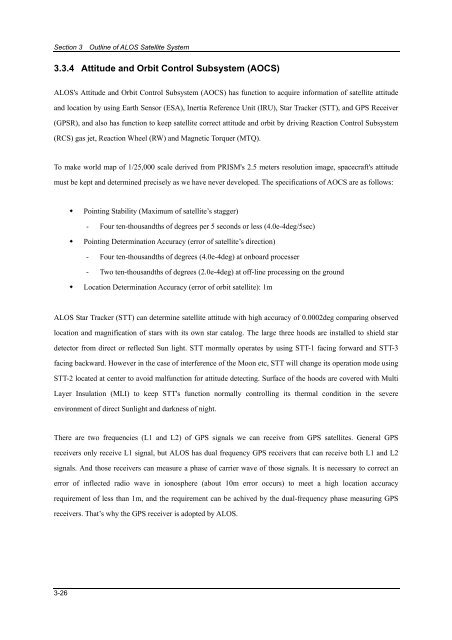
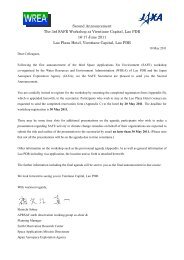
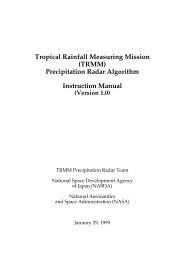

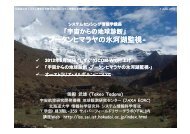
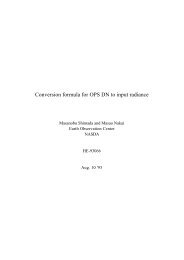
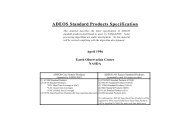
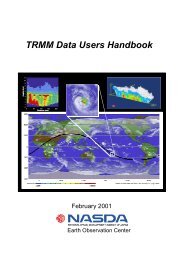
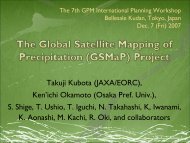
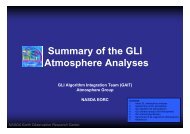
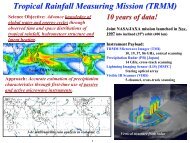
![4.12.2a_Tibet_Wu Guoxiong Tibet-CEOP.ppt[]](https://img.yumpu.com/35802437/1/190x135/4122a-tibet-wu-guoxiong-tibet-ceopppt.jpg?quality=85)
